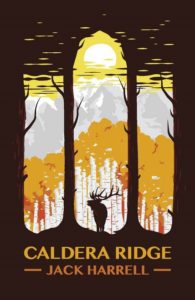 We last heard from Jack Harrell with his 2016 Writing Ourselves, book-length nonfiction on writing itself addressed to Mormons working, studying, or simply fascinated by the intersection of literary activity and theory and Mormonism. This summer, Harrell shows us how it’s done with a new novel, Caldera Ridge from Signature Books.
We last heard from Jack Harrell with his 2016 Writing Ourselves, book-length nonfiction on writing itself addressed to Mormons working, studying, or simply fascinated by the intersection of literary activity and theory and Mormonism. This summer, Harrell shows us how it’s done with a new novel, Caldera Ridge from Signature Books.
In July 2001, I rented a cabin in a nearby Idaho town for a week of writing. I had a newspaper clipping and an idea for a novel. By the end of that week, I had ninety pages of notes and scenes.
Now, after seventeen years and a half-dozen drafts, after countless outlines, wrong turns, character sketches, and notes on plot, that novel, Caldera Ridge, will be published this month by Signature Books.
Looking back at my notes over the years, I’m astonished to discover how often I was wrong about what the book would become. In addition to my journals, I have a box of notes and articles and hand-drawn maps describing the setting. In those pages I find the names of characters I don’t even remember, and descriptions of events that no longer seem relevant to the book at all. For me, fiction writing really is a continuous experience of feeling my way in the dark, with only a vague notion of where I’m going.
But some things do remain constant. That first week of writing in July 2001—the very first afternoon, in fact—I went to lunch at a local hamburger joint where I found a newspaper in a wire rack by the door, the July 13, 2001, issue of Intermountain Farm and Ranch. On the front page was a picture of a man in jeans and a denim shirt, at work on a large irrigation gate. “A Gate Keeper’s Tale” was the title of the article, and the man’s first name was Kail. I picked up that newspaper and knew that Kail would be the name of my main character.
Kail Lambert, the novel’s protagonist, came west just out of high school. His motorcycle broke down in a small Idaho town, and he stayed and soon joined the Mormon church. He fell in love, but after a mission, married a different girl, Charlene, and took her to Arizona, where they had two children. The novel begins fifteen years later, when Kail has slipped—very nearly—into an affair with his first love. But he doesn’t want that, he tells Charlene. Instead, he wants to return to Idaho, to find the hope he once had as a new convert, when he believed God had a plan for his life. From the very first pages of the novel we wonder if Kail and Charlene will make their marriage work—perhaps for the first time.
Early in the novel we see Kail’s first day on the job at the fictional Caldera Ridge State Park, touring the park with Noah Russell, his new boss:
At the edge of the lake, not twenty yards from where they stood, a great blue heron was fishing along the waterline, walking gingerly through the high weeds, taking one careful step, then another, hanging its leg in the air like a doubt.
Noah whispered, “See it?”
Kail noticed the black plume behind the bird’s eye, the blue-gray back, the black stripes on the white foreneck. He stood transfixed. “Beautiful,” he whispered.
“Best part of the job,” Noah said.
The heron had been gazing down at the water as intently as a fortune teller with a crystal ball. Then it lifted its head, and a ripple coursed down its neck before it spread its wings to take flight. The backward, spindly legs might have taken a step or two before dangling lazily behind as the great wings flashing blue and gray exploded into a slow and steady pump. In a moment the massive bird with its six-foot wingspan had folded its head back upon its neck and was rising over the pines in the distance where it disappeared behind a ridge.
A good deal of research went into the book—on topics ranging from Christian theology to Idaho elk populations—as well as numerous visits to area state and national parks, ride-alongs with park rangers, and the help of a friend who spent ten years in the U.S. Forest Service.
But the real discoveries are in the characters and their relationships—the way love, hope, and forgiveness reach their bounds within anyone. Some characters bear the strain and some don’t. In the end, I believe the journey itself is redemptive. I hope readers will feel the same way.
Caldera Ridge was seventeen years in the making. If I’ve learned anything as a writer, it’s this: You can’t tell a novel what to do. It takes a lot of gentleness, long-suffering, and persuasion.
Today I am at work on two new novels, groping in the dark as usual, following those vague notions of what these novels are trying to be. It takes faith—not having all the answers, but believing something good will come.
I just hope it doesn’t take seventeen years!
A native of southeastern Illinois, Jack Harrell is the author of Vernal Promises, which won the Marilyn Brown Novel Award, and A Sense of Order and Other Stories, awarded best short story collection in 2011 by the Association for Mormon Letters. His book, Writing Ourselves: Essays on Creativity, Craft, and Mormonism won the 2017 criticism award from AML. Harrell has published on topics ranging from Mormon literary theory to the aesthetics of death metal music. He teaches writing at Brigham Young University-Idaho.
